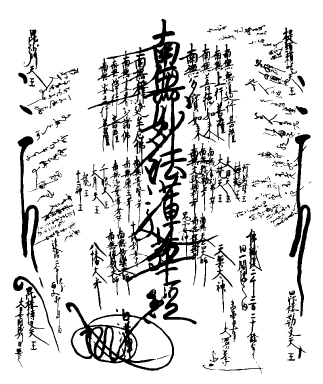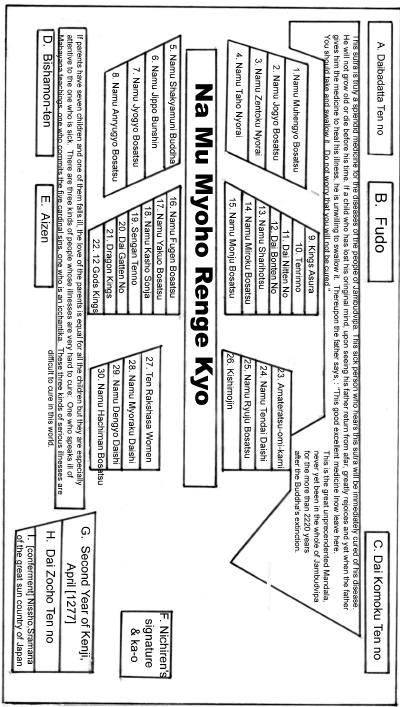
Explanation of the
Kito Prayer Gohonzon

 |
Explanation of the
|  |
 |
From the "Medicine King" chapter 23 of the Lotus Sutra, "This Sutra is good medicine for the sicknesses of those in Jambudvipa. If a sick person gets to hear this Sutra, his sickness will be cured immediately. He will not grow old or die." This passage is also inscribed on other mandalas, namely numbers 38, 39, 40, 47 and 49.The Maltzes translate this same passage as:
"This sutra is truly a splendid medicine for the diseases of the people of Jambudvipa. The sick person who hears this sutra will be immediately cured of his disease. He will not grow old and die before his time."Luigi on the next section:
Various passages from the "Life span" chapter 16 of the Lotus Sutra, "Because they drank the poison, some of the sons have lost their senses / Seeing their father at a distance, they are all greatly happy / In our foolishness, we took some poison by mistake. We pray that you will rescue and heal us / I will now leave this good medicine here for you to take. Have no worries about not recovering." (This is not a literal translation. The meaning has been expanded for clarity).The Maltzes write:
If a child who has lost his original mind, upon seeing his father return from a far, greatly rejoices and yet when the Father gives him the medicine to heal his illnesses, he is unwilling to swallow it. Thereupon the Father says, "This good excellent medicine I now leave here. You should take and swallow it. Do not worry that you will not be cured."Next Luigi writes:
A famous parable from the Nirvana Sutra tells of the parents which take special care of their sick son although they love all their children equally. In the same way, the Buddha particularly cares for sinners. The seven sons are likened to mankind, devas, sravakas, pratyeka-buddhas and the three kinds of bodhisattvas. The passage itself can be translated as, "If parents have seven children and one of them falls ill, the love of the parents is equal for all the children, but they are especially attentive to the one who is sick."The Maltzes translate this as:
Imagine for example if parents have seven children and one of them falls ill. Although the love of the parents is equal for all the children, they are especially sympathetic and attentive to the one who is sick.The Maltzes continue the translation:
This is the Great Unprecedented Mandala [Japanese: Mandara], never yet been in the whole of Jambudvipa for the more than 2220 years after the Buddha's extinction. [Jap: Enbudai (Jambudvipa); the world in which we are living.]
Another passage from the Nirvana Sutra reads, "There are three kinds of people whose illnesses are very hard to cure. First, those who slander Mahayana teachings, second those who commit the five cardinal sins, third, those who are persons of incorrigible disbelief (icchantika). These three kinds of serious illnesses are difficult to cure in this world."The Maltzes expand on this translation thus:
There are three kinds of people whose illnesses are very hard to cure:1. One who speaks ill of Mahayana teachings.These three kinds of illness are extremely serious and difficult to cure in this world. [Only the Lotus Sutra can cure them.]
2. One who commits the five cardinal sins [killing one's father, killing one's mother, killing a saint or arhat, injuring the body of a Buddha, causing disunity in the community of monks].
3. One who is an icchantika [Jap: issendai, a sentient being who, being inherently unreceptive to the teachings of the Buddha, will never attain enlightenment. In the Lotus Sutra, an icchantika could ultimately attain Buddhahood.]
 |
1. Namu Muhengyo-bosatsu |
21. Naga-raja |